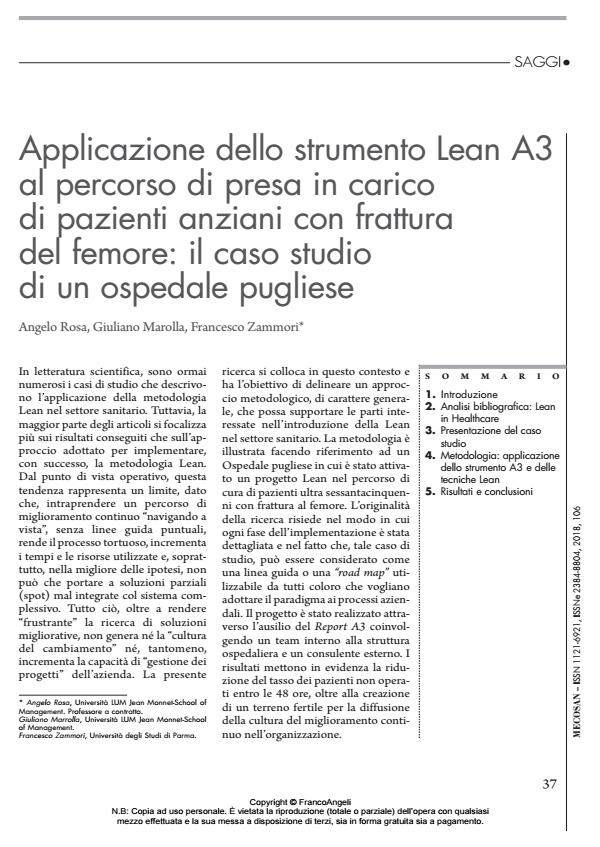Applicazione dello strumento Lean A3 al percorso di presa in carico di pazienti anziani con frattura del femore: il caso studio di un ospedale pugliese
Journal title MECOSAN
Author/s Angelo Rosa, Giuliano Marolla, Francesco Zammori
Publishing Year 2019 Issue 2018/106
Language Italian Pages 27 P. 37-63 File size 845 KB
DOI 10.3280/MESA2018-106003
DOI is like a bar code for intellectual property: to have more infomation
click here
Below, you can see the article first page
If you want to buy this article in PDF format, you can do it, following the instructions to buy download credits

FrancoAngeli is member of Publishers International Linking Association, Inc (PILA), a not-for-profit association which run the CrossRef service enabling links to and from online scholarly content.
Despite numerous articles reporting the application of Lean in the health sector, the methodologies to implementing the paradigm in hospitals are described in few articles. Most of the research focuses more on the results of the Lean approach than on the approach itself. Embarking on continuous improvement by navigating without compass and without guidelines can be frustrating and in the best case could lead to silver bullet solution, spending resources without generating the "culture of change" or increasing the ability to "project management". The purpose of this paper is to describe the case study of a Puglia hospital in which a Lean project was activated to the clinical pathway of patients over sixty-five with fracture of the femur. The originality is to detail the framework to support Lean implementation and offer a guideline to practitioners. The project was implemented through the Report A3, involving a hospital team work and an external consultant. The results show a reduction in the rate of the patients who cannot undergo surgery in 48 hours and the spreading of continuous improvement culture in the organization.
Keywords: Lean, Case Study, Report A3, Continuous Improvement, Organization, Healthcare
- Lean Six Sigma to reduce the acute myocardial infarction mortality rate: a single center study Angelo Rosa, Teresa Angela Trunfio, Giuliano Marolla, Antonietta Costantino, Davide Nardella, Olivia McDermott, in The TQM Journal /2023 pp.25
DOI: 10.1108/TQM-03-2022-0082 - Integrazione Ospedale territorio: una roadmap per la ri-organizzazione dei processi ADI nel DM77/2022 in ottica Patient-centred Giuliano Marolla, Angelo Rosa, Luigi Rossi, Luigi Fruscio, Rosa Squicciarini, in MECOSAN 131/2025 pp.105
DOI: 10.3280/mesa2024-131oa20245
Angelo Rosa, Giuliano Marolla, Francesco Zammori, Applicazione dello strumento Lean A3 al percorso di presa in carico di pazienti anziani con frattura del femore: il caso studio di un ospedale pugliese in "MECOSAN" 106/2018, pp 37-63, DOI: 10.3280/MESA2018-106003